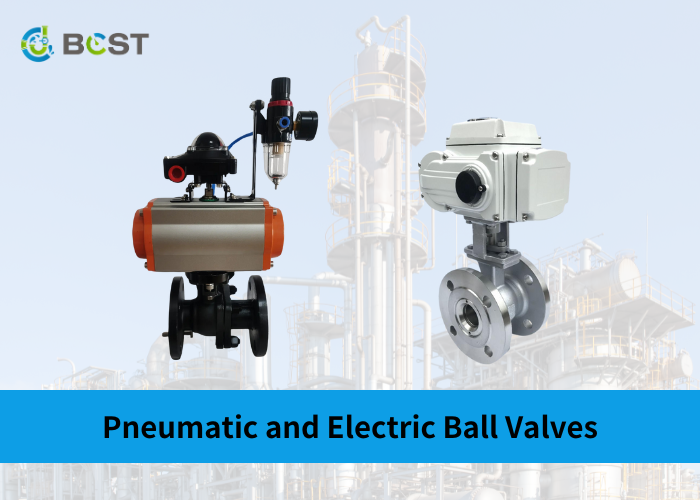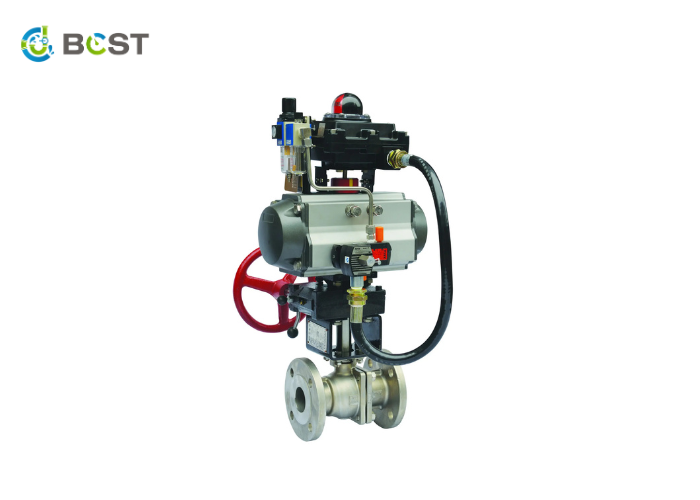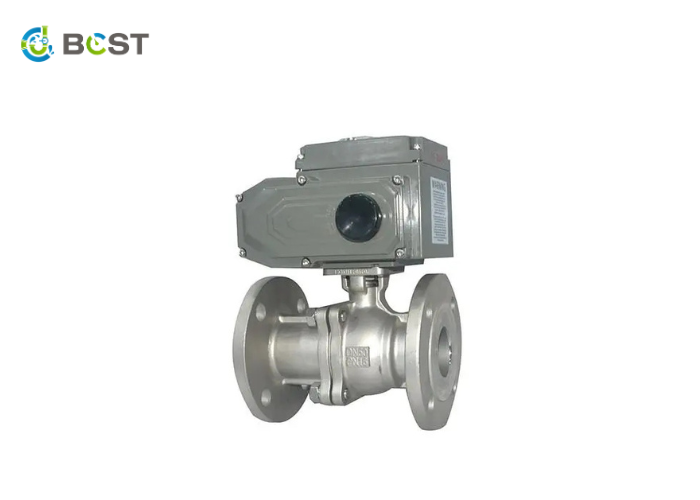
These valves, akin to conductors in an industrial orchestra, play a pivotal role in directing the flow of fluids with unparalleled accuracy. In this blog, we embark on a journey to unravel the inner workings of Pneumatic and Electric Ball Valves, exploring the fundamental principles that govern their operation. From the swift response of compressed air in pneumatic systems to the precise modulation driven by electric power, each valve type boasts unique features that cater to diverse industrial needs.
For automation and/or remote control, ball valves can be paired with a pneumatic actuator (pneumatic ball valves) or an electric actuator (electric ball valves). Depending on the application, using a pneumatic actuator rather than an electric actuator may be more advantageous, or vice versa. We shall compare the two options in this essay.
What is a Ball Valve?
A ball valve is a quarter-turn valve that controls the flow of a medium by using a hollow rotating ball. A sectional view of the key components of a manual ball valve is depicted in the picture. When the hollow portion of the ball is in contact with the flow (pipe or hose), the valve opens and allows the media to pass through. The valve closes when the solid portion of the ball is in line with the flow, which is accomplished by rotating the ball 90 degrees (thus the term quarter-turn valve).
It is also possible to set the valve between open and entirely closed, allowing for more precise flow regulation. Ball valves typically have two ports, one for inlet and one for outflow. However, three ports (L or T) are also available, and how the valve is built and installed determines how the ball’s 90-degree rotation directs the media flow. Four-port ball valves are feasible but uncommon.
A valve stem is linked to the ball and controls its rotation in ball valves. To activate the valve, the valve stem is attached to a manual handle in Figure 2. The valve stems, on the other hand, can be linked to a pneumatic or electric rotary actuator, which spins the stem to open and/or close the ball valve automatically and/or remotely.
What is an Actuator?
A valve actuator is a device that allows you to manipulate a valve from a distance. The actuator is known as a quarter-turn actuator if it controls a quarter-turn valve. Instead of a manual lever, you can install an actuator on the valve to control it automatically and remotely. Actuators create the torque required to operate (rotate) a ball valve using a power source. Most actuators are powered by pneumatic, electric, or hydraulic systems (not covered in this article). The difference in this power source results in multiple designs, each with its own set of advantages and disadvantages for specific applications (described below). An actuator may have features such as position indications and manual override in addition to the torque-generating component.
What is a Pneumatic Actuator?
By converting compressed air energy to mechanical motion, pneumatic actuators drive ball valves. A ball valve requires a rotating mechanical action to turn 90 degrees. Single-acting and double-acting pneumatic actuator ball valves are available. A single-acting pneumatic actuator turns the valve with a single compressed air input and a spring to return it to its usual position. Two compressed air inputs are used by a double-acting pneumatic actuator to turn the valve and return it to its original position.
Pneumatic Actuator Operating Principle
The rack and pinion mechanism is the most popular type of pneumatic actuator for ball valves. Figure 4 shows the rack (a linear gear) and the pinion (a circular gear). To achieve linear motion, the rack is coupled to a piston that is pushed by compressed air. The pinion converts this linear motion to circular motion. The pinion moves the stem of a ball valve open and closed.
Solenoid valves manage pressurized air to control the pneumatic actuator for ball valves. Electrical impulses from the controller activate the solenoid valve, allowing pressurized air to flow through to both piston sides of the pneumatic actuator. The piston pushes the rack, which turns the pinion attached to the ball valve stem.
What is an Electric Actuator?
Electric actuators employ an electric motor to move a ball valve through 90 degrees, converting electrical energy into rotary force. They are an energy-efficient, clean, and silent valve control technology. An alternating current (AC) or direct current (DC) can power an electric motor. It is housed in a sturdy, compact housing that also houses the actuator’s other components such as gearings, limit switches, wiring, and so on. The entire assembly is linked to a valve using an appropriate connection interface, such as ISO 5211.

Electric Actuator Operating Principle
The electric motor provides torque, which is delivered to the valve stem via a shaft. This causes the ball valve to revolve. A gear system is coupled to the electric motor shaft to provide the desired torque. The torque capability is an important consideration when choosing an actuator. It must be more than the necessary torque (breakaway torque) to turn the ball valve by a particular percentage, which is frequently defined by the ball valve manufacturer. The breakaway torque is the smallest amount of torque required to turn the ball valve, which is normally in the completely closed or fully open static positions.
The response time (speed of operation) of an electric actuator is inversely related to the torque of the actuator. The gear system defines the speed-torque relationship. A higher gear ratio produces more torque but has a shorter response time.
Electric actuators can be powered by direct current (12, 24, and 48V) or alternating current (24, 48, 120, 130, and 240V). Limit switches are installed to prevent current from flowing to the motor when fully closed and open. Modulating control can be accomplished with electric motors. This precisely puts the valve between fully open and fully closed positions (i.e., 0° and 90°). This can be used to control the flow rate through the valve. To modulate the electric motor, a positioning circuit board (PCB) is fitted to the electric actuator.
Actuator and a Ball Valve
Although actuators and ball valves are distinct components, they are frequently used in tandem. As a result, purchasing them as a bundle is more convenient for ensuring conformance. When an actuator and a ball valve are combined, you obtain an automatic ball valve that can be operated remotely. A connection interface connects the actuator to the ball valve. The connecting interface consists of a shaft, or stem, that connects the valve ball to the actuator and a flange that secures the actuator to the valve. This interface could be brand-specific or conform to standards like ISO 5211. A compatible brand-specific valve can be fitted with a brand-specific actuator. Different ball valves and actuators, on the other hand, can be interchanged as long as they adhere to the same standard, such as the ISO 5211 standard.
Pneumatic Ball Valves vs. Electric Ball Valves
- The essential difference between electric and pneumatic ball valves is using different actuators. Generally, various actuators are selected according to the requirements of working conditions. For example, in chemical and other occasions where explosion-proof is required, pneumatic valves are most used because they are cheap and easy to operate. It also has an intelligent locator that meets high-security requirements.
- Pneumatic ball valves have more force than electric ball valves. The opening and closing action and speed of the pneumatic valve can be adjusted. Simple structure. Easy to protect. Because of the buffering capabilities of the gas, it is difficult to damage owing to a blockage during operation. However, it requires an air supply and has a more complicated control system than an electric ball valve. Pneumatic ball valves are flexible, safe and reliable. Many places with high control requirements have established compressed air stations using pneumatic external control elements.Pneumatic ball valves are flexible, safe and reliable. Many places with high control requirements have established compressed air stations using pneumatic external control elements. The pneumatic actuator’s power source is air, and the electric control signal is transformed into a pneumatic control signal by the positioner to drive the pneumatic actuator and modify the valve position.
- The power supply of the electric valve actuator is the power supply, and its circuit board or motor is prone to sparks, so it is generally used in places with low environmental requirements and no risk. Electric ball valves are slower than pneumatic ball valves. Under normal conditions, the pneumatic ball valve opens and closes in about 6 seconds, whereas the electric ball valve opens and closes in around 15-20 seconds.
- An electric ball valve has the benefit of having a good effect on liquid medium and large-diameter gas and is not affected by weather or compressed air pressure. High cost and poor performance in damp settings are disadvantages. A pneumatic ball valve’s merits include its good effect on gaseous medium and small diameter liquid, low cost, and convenient protection.
Pneumatic ball valves outperform electric ball valves. The electric ball valve operates swiftly and is suitable for locations without external air sources; nevertheless, its safety function is inadequate, and it is difficult to use in combustible and explosive environments with high explosion-proof criteria. The performance of the electric ball valve during operation is not as steady as that of the pneumatic ball valve, and the cost and maintenance costs are considerable. However, the pneumatic ball valve can fully meet the control requirements and is simple to operate. It has a reasonably good safety function and is ideal for places with high explosion-proof requirements, such as flammable and explosive environments.

Final Thoughts
It becomes evident that the choice between pneumatic and electric actuators is a nuanced decision deeply rooted in application-specific requirements. The dynamic interplay of compressed air and electrical power, embodied by pneumatic and electric ball valves respectively, offers a spectrum of advantages tailored to diverse industrial needs. The key takeaway lies in the strategic understanding of when to leverage the swift responsiveness of pneumatic actuators and when to tap into the precision and adaptability of electric actuators. In the ever-evolving landscape of fluid control systems, this thoughtful integration of technology not only ensures optimal performance but also paves the way for continued innovation in the pursuit of efficiency and excellence. As industries embrace the possibilities presented by these versatile partnerships, the seamless marriage of ball valves with pneumatic or electric actuators remains at the forefront of shaping the future of automated and remotely controlled processes.






